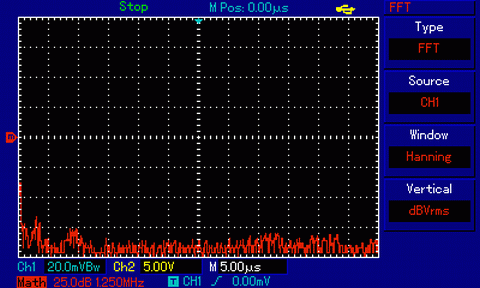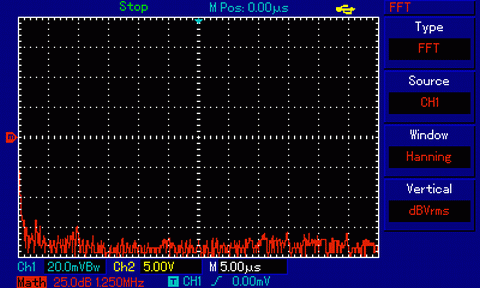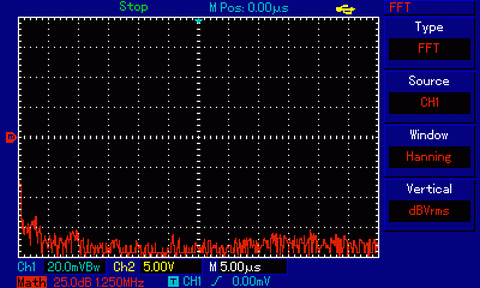Saga of LED lamps. Part 5 - some noise measurements
Recently, acquaintances showed me an article from July twenty-fourth of this year, in which the author was doing something similar to what I was doing - I analyzed LED lamps. Among other things, it made some assessments of radio interference emitted by lamps. Looking at this, I thought that it would be good for me to try to estimate the electromagnetic radiation of the existing lamps.
To do this, I connected a piece of wire about 10 cm long to the oscilloscope probe as an antenna and watched the spectrum of the received signal. The lamps for all measurements were at a distance of about 15 cm from the antenna.
')

In general, I did not quite understand why the author of the article in question did not do just that, although perhaps there were reasons for this. I proceeded from the following considerations:
1. It is very unlikely that the lamp emits something on the VHF.
The average frequency of the ballasts is about 100 kHz, the maximum that I saw in practice is about megahertz. In this case, the harmonics of the fundamental tone attenuate very strongly with an increase in their number — it seems to me that the effect of tones from, say, the fifteenth and beyond is unlikely. So you can limit the range somewhere up to 15 MHz - should be enough with a margin. It must be said that in the spectrum of signal harmonics there are rarely “holes” - there is a very small chance that everything will be quiet down in frequency, and, say, a peak will emerge at 100 MHz. For this, the stars must become somehow special (somewhere on the parasitic elements of the circuit must form a local oscillator and a mixer) or the signal must be very tricky.
If we talk about the receiver, then the noise from the lamps is accepted by them rather than by the “correct” path, but by direct wiring to the installation, or by filtering through filters (since the signal from a nearby lamp is likely to be more powerful than a signal from a distant radio station).
2. The sensitivity of the Leningrad-006 receiver is 150 uV in the HF range. The noise threshold of my oscilloscope in FFT mode is about -80 dBV RMS , which, in terms of the rms input voltage, is 100 uV, that is, in principle, not worse than the named receiver.
Actually, the noise threshold:

25 dBV RMS per vertical division, 1.25 MHz per horizontal division. Thus, we are able to observe signals up to 15 MHz in the range of about 80 dBV RMS , taking into account the noise threshold. All subsequent graphs will be shown with the same grid.
On the spectrum, by the way, visible interference from the power source of my computer. So further it will be necessary to keep in mind that the peaks in this area do not apply to lamps.
Let's start with interesting. For example, here is the Ecola 12W (D7LW12ELC):

Everything is as it should be, the classic spectrum of a sequence of rectangular pulses.
And yes, this is almost everything. The rest is not so interesting. In the case of Gauss, for example, it’s generally boring - all the tested lamps of this brand practically do not radiate. For example, Gauss Elementary 6.5 W:

Clean noise threshold. Does not emit anything that could be caught. It seems that the power circuits there are traced very well.
Kosmos and SvetaLED are also quiet, but somewhere, I would say, 800 kHz, there is a noticeable slight excess of the noise threshold, although it may seem to me.
Kosmos Premium 12 W:

SvetaLED 11 W:

Alas, I did not measure other lamps. A part was disassembled, but there is nothing to radiate in lamps with capacitor ballast.
As can be seen, only Ecola stands out from the tested one — it is even interesting to disassemble it and see what is inside there (large interference can be caused by poor quality of installation). Everything else is almost no noise in the radio.
I must inform you that, starting with this publication, I can hardly withstand the weekly cycle of issuing material. The fact is that, in addition to engineering practice, I finish the magistracy on the full-time department. The session is coming, and it is necessary to finish the diploma ... So I turn to a free schedule. This does not mean that the promised measurements of new lamps and the expected table will not be - everything will definitely be. But, nevertheless, it is possible that not next Thursday, but somewhat later. I hope for a general understanding. Thank.
Friends! This is the second time I've got a message in a personal message that, de, “ about measures” is a typo. No, comrades, there is such a word ! Among its synonyms are "measurement", "measurement", "miscalculation" and more, depending on the context. Here, of course, refers to "measurement" in the meaning of its result.
To do this, I connected a piece of wire about 10 cm long to the oscilloscope probe as an antenna and watched the spectrum of the received signal. The lamps for all measurements were at a distance of about 15 cm from the antenna.
')

In general, I did not quite understand why the author of the article in question did not do just that, although perhaps there were reasons for this. I proceeded from the following considerations:
1. It is very unlikely that the lamp emits something on the VHF.
The average frequency of the ballasts is about 100 kHz, the maximum that I saw in practice is about megahertz. In this case, the harmonics of the fundamental tone attenuate very strongly with an increase in their number — it seems to me that the effect of tones from, say, the fifteenth and beyond is unlikely. So you can limit the range somewhere up to 15 MHz - should be enough with a margin. It must be said that in the spectrum of signal harmonics there are rarely “holes” - there is a very small chance that everything will be quiet down in frequency, and, say, a peak will emerge at 100 MHz. For this, the stars must become somehow special (somewhere on the parasitic elements of the circuit must form a local oscillator and a mixer) or the signal must be very tricky.
If we talk about the receiver, then the noise from the lamps is accepted by them rather than by the “correct” path, but by direct wiring to the installation, or by filtering through filters (since the signal from a nearby lamp is likely to be more powerful than a signal from a distant radio station).
2. The sensitivity of the Leningrad-006 receiver is 150 uV in the HF range. The noise threshold of my oscilloscope in FFT mode is about -80 dBV RMS , which, in terms of the rms input voltage, is 100 uV, that is, in principle, not worse than the named receiver.
Actually, the noise threshold:

25 dBV RMS per vertical division, 1.25 MHz per horizontal division. Thus, we are able to observe signals up to 15 MHz in the range of about 80 dBV RMS , taking into account the noise threshold. All subsequent graphs will be shown with the same grid.
On the spectrum, by the way, visible interference from the power source of my computer. So further it will be necessary to keep in mind that the peaks in this area do not apply to lamps.
Let's start with interesting. For example, here is the Ecola 12W (D7LW12ELC):

Everything is as it should be, the classic spectrum of a sequence of rectangular pulses.
And yes, this is almost everything. The rest is not so interesting. In the case of Gauss, for example, it’s generally boring - all the tested lamps of this brand practically do not radiate. For example, Gauss Elementary 6.5 W:

Clean noise threshold. Does not emit anything that could be caught. It seems that the power circuits there are traced very well.
Kosmos and SvetaLED are also quiet, but somewhere, I would say, 800 kHz, there is a noticeable slight excess of the noise threshold, although it may seem to me.
Kosmos Premium 12 W:

SvetaLED 11 W:

Alas, I did not measure other lamps. A part was disassembled, but there is nothing to radiate in lamps with capacitor ballast.
As can be seen, only Ecola stands out from the tested one — it is even interesting to disassemble it and see what is inside there (large interference can be caused by poor quality of installation). Everything else is almost no noise in the radio.
PS
I must inform you that, starting with this publication, I can hardly withstand the weekly cycle of issuing material. The fact is that, in addition to engineering practice, I finish the magistracy on the full-time department. The session is coming, and it is necessary to finish the diploma ... So I turn to a free schedule. This does not mean that the promised measurements of new lamps and the expected table will not be - everything will definitely be. But, nevertheless, it is possible that not next Thursday, but somewhat later. I hope for a general understanding. Thank.
Pps
Friends! This is the second time I've got a message in a personal message that, de, “ about measures” is a typo. No, comrades, there is such a word ! Among its synonyms are "measurement", "measurement", "miscalculation" and more, depending on the context. Here, of course, refers to "measurement" in the meaning of its result.
Source: https://habr.com/ru/post/364269/
All Articles